Comprehensive Marketing Report: Concepts, Tools, and Value Proposition
VerifiedAdded on 2022/09/16
|10
|1651
|29
Report
AI Summary
This report provides a comprehensive overview of marketing, beginning with the fundamental definition and the roles of marketers. It delves into core marketing concepts, including the STP process (Segmentation, Targeting, and Positioning), and the tools used by marketers, such as the marketing mix (7Ps). The report explores various marketing philosophies, including production, product, selling, marketing, and holistic orientations, and discusses their relevance. It also covers the core marketing concepts of needs, wants, and demands, and explains the value proposition and customer-perceived value. The report uses examples like the 'ugly veggies' study to illustrate how marketing can shape markets and influence consumer behavior. Overall, the report offers valuable insights into the principles and practices of effective marketing, making it a useful resource for students studying marketing.
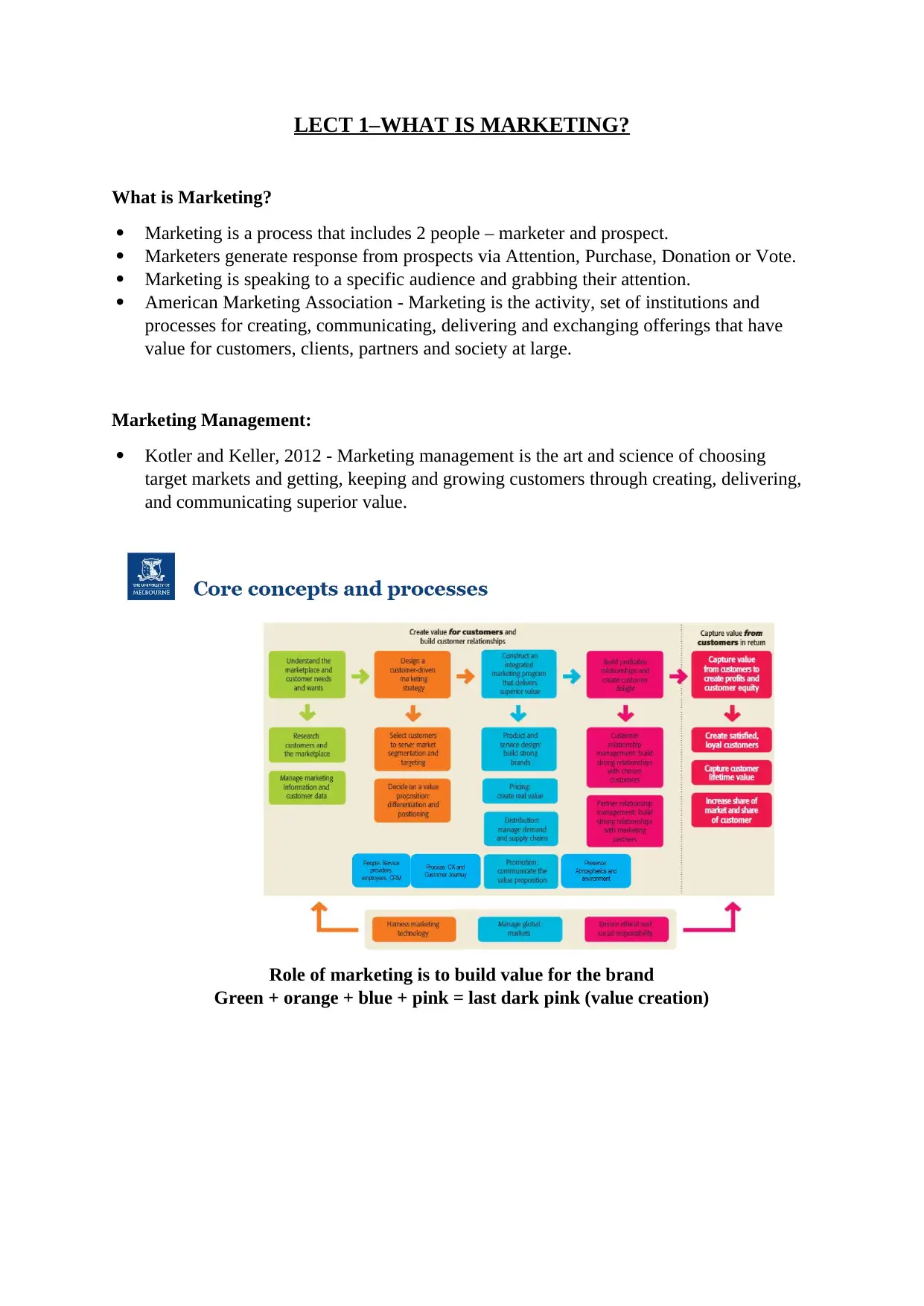
LECT 1–WHAT IS MARKETING?
What is Marketing?
Marketing is a process that includes 2 people – marketer and prospect.
Marketers generate response from prospects via Attention, Purchase, Donation or Vote.
Marketing is speaking to a specific audience and grabbing their attention.
American Marketing Association - Marketing is the activity, set of institutions and
processes for creating, communicating, delivering and exchanging offerings that have
value for customers, clients, partners and society at large.
Marketing Management:
Kotler and Keller, 2012 - Marketing management is the art and science of choosing
target markets and getting, keeping and growing customers through creating, delivering,
and communicating superior value.
Role of marketing is to build value for the brand
Green + orange + blue + pink = last dark pink (value creation)
What is Marketing?
Marketing is a process that includes 2 people – marketer and prospect.
Marketers generate response from prospects via Attention, Purchase, Donation or Vote.
Marketing is speaking to a specific audience and grabbing their attention.
American Marketing Association - Marketing is the activity, set of institutions and
processes for creating, communicating, delivering and exchanging offerings that have
value for customers, clients, partners and society at large.
Marketing Management:
Kotler and Keller, 2012 - Marketing management is the art and science of choosing
target markets and getting, keeping and growing customers through creating, delivering,
and communicating superior value.
Role of marketing is to build value for the brand
Green + orange + blue + pink = last dark pink (value creation)
Paraphrase This Document
Need a fresh take? Get an instant paraphrase of this document with our AI Paraphraser
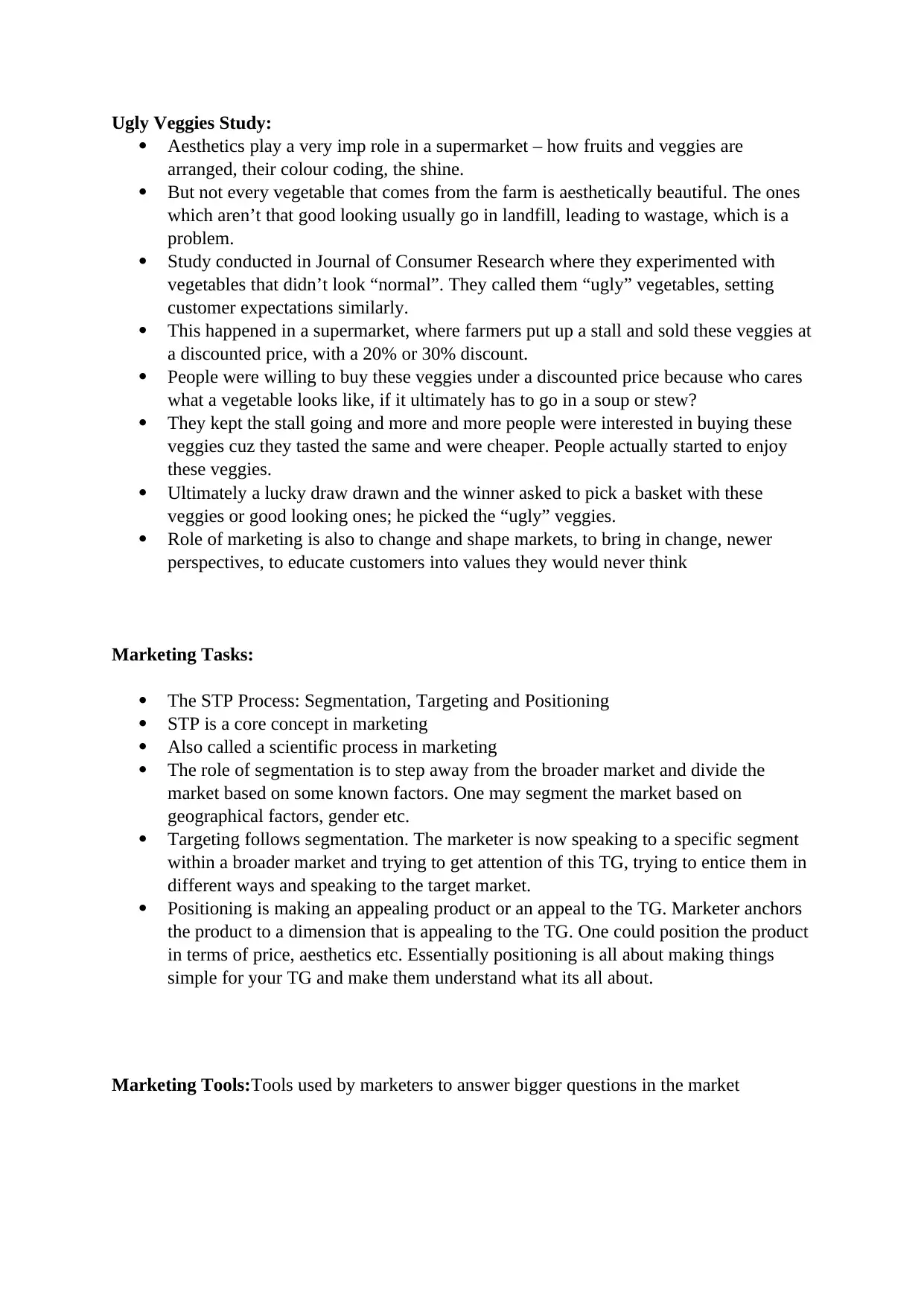
Ugly Veggies Study:
Aesthetics play a very imp role in a supermarket – how fruits and veggies are
arranged, their colour coding, the shine.
But not every vegetable that comes from the farm is aesthetically beautiful. The ones
which aren’t that good looking usually go in landfill, leading to wastage, which is a
problem.
Study conducted in Journal of Consumer Research where they experimented with
vegetables that didn’t look “normal”. They called them “ugly” vegetables, setting
customer expectations similarly.
This happened in a supermarket, where farmers put up a stall and sold these veggies at
a discounted price, with a 20% or 30% discount.
People were willing to buy these veggies under a discounted price because who cares
what a vegetable looks like, if it ultimately has to go in a soup or stew?
They kept the stall going and more and more people were interested in buying these
veggies cuz they tasted the same and were cheaper. People actually started to enjoy
these veggies.
Ultimately a lucky draw drawn and the winner asked to pick a basket with these
veggies or good looking ones; he picked the “ugly” veggies.
Role of marketing is also to change and shape markets, to bring in change, newer
perspectives, to educate customers into values they would never think
Marketing Tasks:
The STP Process: Segmentation, Targeting and Positioning
STP is a core concept in marketing
Also called a scientific process in marketing
The role of segmentation is to step away from the broader market and divide the
market based on some known factors. One may segment the market based on
geographical factors, gender etc.
Targeting follows segmentation. The marketer is now speaking to a specific segment
within a broader market and trying to get attention of this TG, trying to entice them in
different ways and speaking to the target market.
Positioning is making an appealing product or an appeal to the TG. Marketer anchors
the product to a dimension that is appealing to the TG. One could position the product
in terms of price, aesthetics etc. Essentially positioning is all about making things
simple for your TG and make them understand what its all about.
Marketing Tools:Tools used by marketers to answer bigger questions in the market
Aesthetics play a very imp role in a supermarket – how fruits and veggies are
arranged, their colour coding, the shine.
But not every vegetable that comes from the farm is aesthetically beautiful. The ones
which aren’t that good looking usually go in landfill, leading to wastage, which is a
problem.
Study conducted in Journal of Consumer Research where they experimented with
vegetables that didn’t look “normal”. They called them “ugly” vegetables, setting
customer expectations similarly.
This happened in a supermarket, where farmers put up a stall and sold these veggies at
a discounted price, with a 20% or 30% discount.
People were willing to buy these veggies under a discounted price because who cares
what a vegetable looks like, if it ultimately has to go in a soup or stew?
They kept the stall going and more and more people were interested in buying these
veggies cuz they tasted the same and were cheaper. People actually started to enjoy
these veggies.
Ultimately a lucky draw drawn and the winner asked to pick a basket with these
veggies or good looking ones; he picked the “ugly” veggies.
Role of marketing is also to change and shape markets, to bring in change, newer
perspectives, to educate customers into values they would never think
Marketing Tasks:
The STP Process: Segmentation, Targeting and Positioning
STP is a core concept in marketing
Also called a scientific process in marketing
The role of segmentation is to step away from the broader market and divide the
market based on some known factors. One may segment the market based on
geographical factors, gender etc.
Targeting follows segmentation. The marketer is now speaking to a specific segment
within a broader market and trying to get attention of this TG, trying to entice them in
different ways and speaking to the target market.
Positioning is making an appealing product or an appeal to the TG. Marketer anchors
the product to a dimension that is appealing to the TG. One could position the product
in terms of price, aesthetics etc. Essentially positioning is all about making things
simple for your TG and make them understand what its all about.
Marketing Tools:Tools used by marketers to answer bigger questions in the market
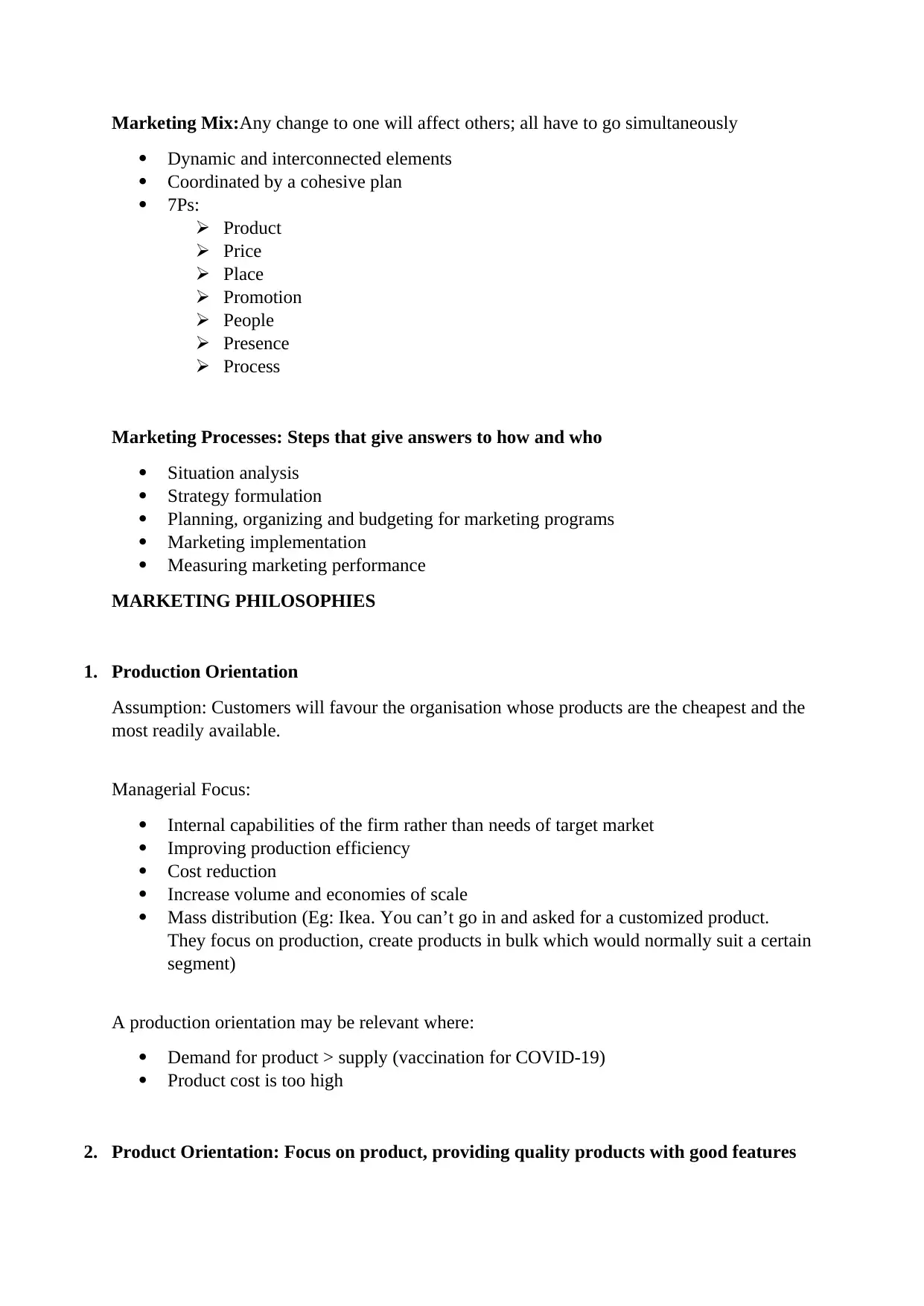
Marketing Mix:Any change to one will affect others; all have to go simultaneously
Dynamic and interconnected elements
Coordinated by a cohesive plan
7Ps:
Product
Price
Place
Promotion
People
Presence
Process
Marketing Processes: Steps that give answers to how and who
Situation analysis
Strategy formulation
Planning, organizing and budgeting for marketing programs
Marketing implementation
Measuring marketing performance
MARKETING PHILOSOPHIES
1. Production Orientation
Assumption: Customers will favour the organisation whose products are the cheapest and the
most readily available.
Managerial Focus:
Internal capabilities of the firm rather than needs of target market
Improving production efficiency
Cost reduction
Increase volume and economies of scale
Mass distribution (Eg: Ikea. You can’t go in and asked for a customized product.
They focus on production, create products in bulk which would normally suit a certain
segment)
A production orientation may be relevant where:
Demand for product > supply (vaccination for COVID-19)
Product cost is too high
2. Product Orientation: Focus on product, providing quality products with good features
Dynamic and interconnected elements
Coordinated by a cohesive plan
7Ps:
Product
Price
Place
Promotion
People
Presence
Process
Marketing Processes: Steps that give answers to how and who
Situation analysis
Strategy formulation
Planning, organizing and budgeting for marketing programs
Marketing implementation
Measuring marketing performance
MARKETING PHILOSOPHIES
1. Production Orientation
Assumption: Customers will favour the organisation whose products are the cheapest and the
most readily available.
Managerial Focus:
Internal capabilities of the firm rather than needs of target market
Improving production efficiency
Cost reduction
Increase volume and economies of scale
Mass distribution (Eg: Ikea. You can’t go in and asked for a customized product.
They focus on production, create products in bulk which would normally suit a certain
segment)
A production orientation may be relevant where:
Demand for product > supply (vaccination for COVID-19)
Product cost is too high
2. Product Orientation: Focus on product, providing quality products with good features
⊘ This is a preview!⊘
Do you want full access?
Subscribe today to unlock all pages.

Trusted by 1+ million students worldwide
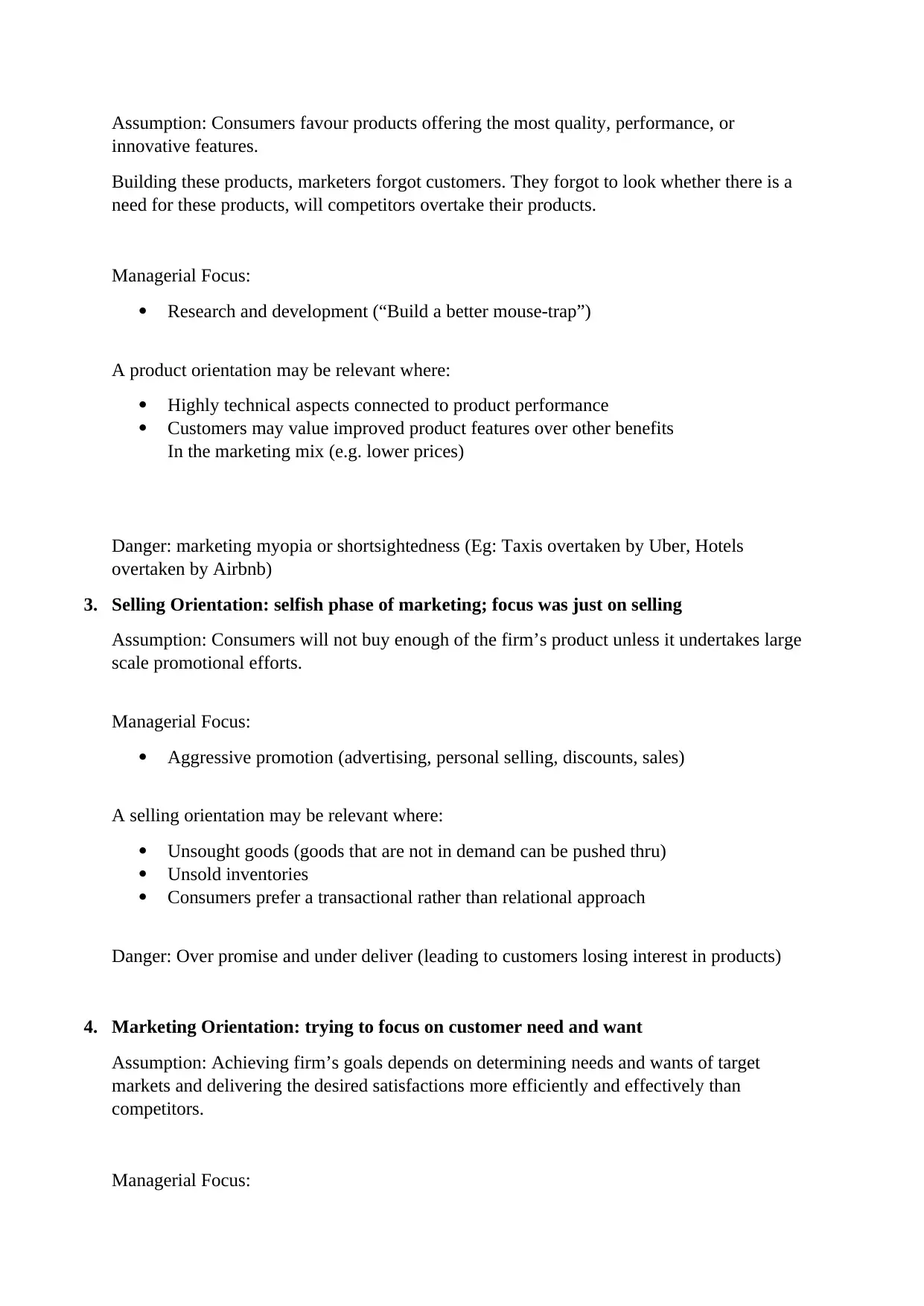
Assumption: Consumers favour products offering the most quality, performance, or
innovative features.
Building these products, marketers forgot customers. They forgot to look whether there is a
need for these products, will competitors overtake their products.
Managerial Focus:
Research and development (“Build a better mouse-trap”)
A product orientation may be relevant where:
Highly technical aspects connected to product performance
Customers may value improved product features over other benefits
In the marketing mix (e.g. lower prices)
Danger: marketing myopia or shortsightedness (Eg: Taxis overtaken by Uber, Hotels
overtaken by Airbnb)
3. Selling Orientation: selfish phase of marketing; focus was just on selling
Assumption: Consumers will not buy enough of the firm’s product unless it undertakes large
scale promotional efforts.
Managerial Focus:
Aggressive promotion (advertising, personal selling, discounts, sales)
A selling orientation may be relevant where:
Unsought goods (goods that are not in demand can be pushed thru)
Unsold inventories
Consumers prefer a transactional rather than relational approach
Danger: Over promise and under deliver (leading to customers losing interest in products)
4. Marketing Orientation: trying to focus on customer need and want
Assumption: Achieving firm’s goals depends on determining needs and wants of target
markets and delivering the desired satisfactions more efficiently and effectively than
competitors.
Managerial Focus:
innovative features.
Building these products, marketers forgot customers. They forgot to look whether there is a
need for these products, will competitors overtake their products.
Managerial Focus:
Research and development (“Build a better mouse-trap”)
A product orientation may be relevant where:
Highly technical aspects connected to product performance
Customers may value improved product features over other benefits
In the marketing mix (e.g. lower prices)
Danger: marketing myopia or shortsightedness (Eg: Taxis overtaken by Uber, Hotels
overtaken by Airbnb)
3. Selling Orientation: selfish phase of marketing; focus was just on selling
Assumption: Consumers will not buy enough of the firm’s product unless it undertakes large
scale promotional efforts.
Managerial Focus:
Aggressive promotion (advertising, personal selling, discounts, sales)
A selling orientation may be relevant where:
Unsought goods (goods that are not in demand can be pushed thru)
Unsold inventories
Consumers prefer a transactional rather than relational approach
Danger: Over promise and under deliver (leading to customers losing interest in products)
4. Marketing Orientation: trying to focus on customer need and want
Assumption: Achieving firm’s goals depends on determining needs and wants of target
markets and delivering the desired satisfactions more efficiently and effectively than
competitors.
Managerial Focus:
Paraphrase This Document
Need a fresh take? Get an instant paraphrase of this document with our AI Paraphraser
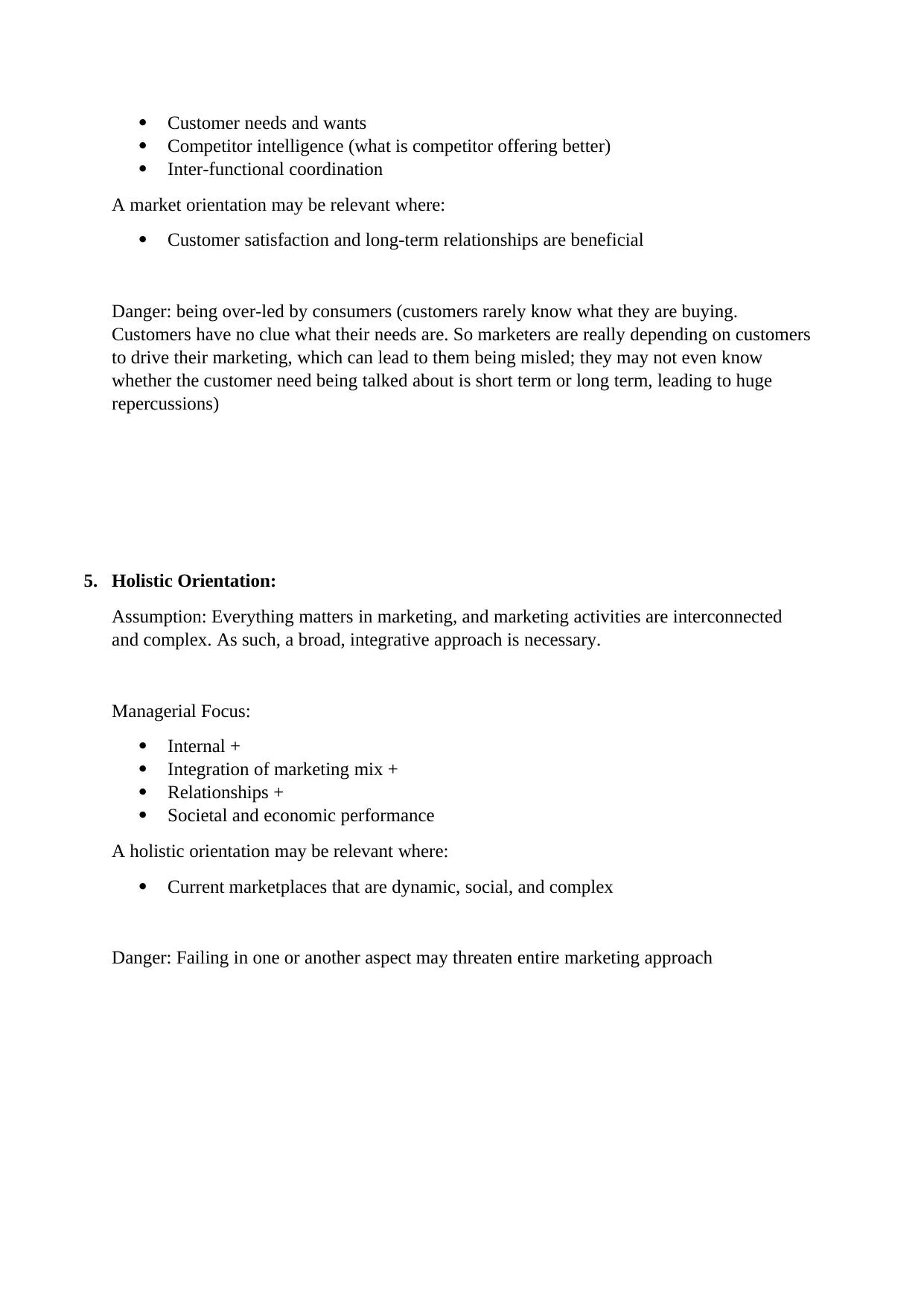
Customer needs and wants
Competitor intelligence (what is competitor offering better)
Inter-functional coordination
A market orientation may be relevant where:
Customer satisfaction and long-term relationships are beneficial
Danger: being over-led by consumers (customers rarely know what they are buying.
Customers have no clue what their needs are. So marketers are really depending on customers
to drive their marketing, which can lead to them being misled; they may not even know
whether the customer need being talked about is short term or long term, leading to huge
repercussions)
5. Holistic Orientation:
Assumption: Everything matters in marketing, and marketing activities are interconnected
and complex. As such, a broad, integrative approach is necessary.
Managerial Focus:
Internal +
Integration of marketing mix +
Relationships +
Societal and economic performance
A holistic orientation may be relevant where:
Current marketplaces that are dynamic, social, and complex
Danger: Failing in one or another aspect may threaten entire marketing approach
Competitor intelligence (what is competitor offering better)
Inter-functional coordination
A market orientation may be relevant where:
Customer satisfaction and long-term relationships are beneficial
Danger: being over-led by consumers (customers rarely know what they are buying.
Customers have no clue what their needs are. So marketers are really depending on customers
to drive their marketing, which can lead to them being misled; they may not even know
whether the customer need being talked about is short term or long term, leading to huge
repercussions)
5. Holistic Orientation:
Assumption: Everything matters in marketing, and marketing activities are interconnected
and complex. As such, a broad, integrative approach is necessary.
Managerial Focus:
Internal +
Integration of marketing mix +
Relationships +
Societal and economic performance
A holistic orientation may be relevant where:
Current marketplaces that are dynamic, social, and complex
Danger: Failing in one or another aspect may threaten entire marketing approach
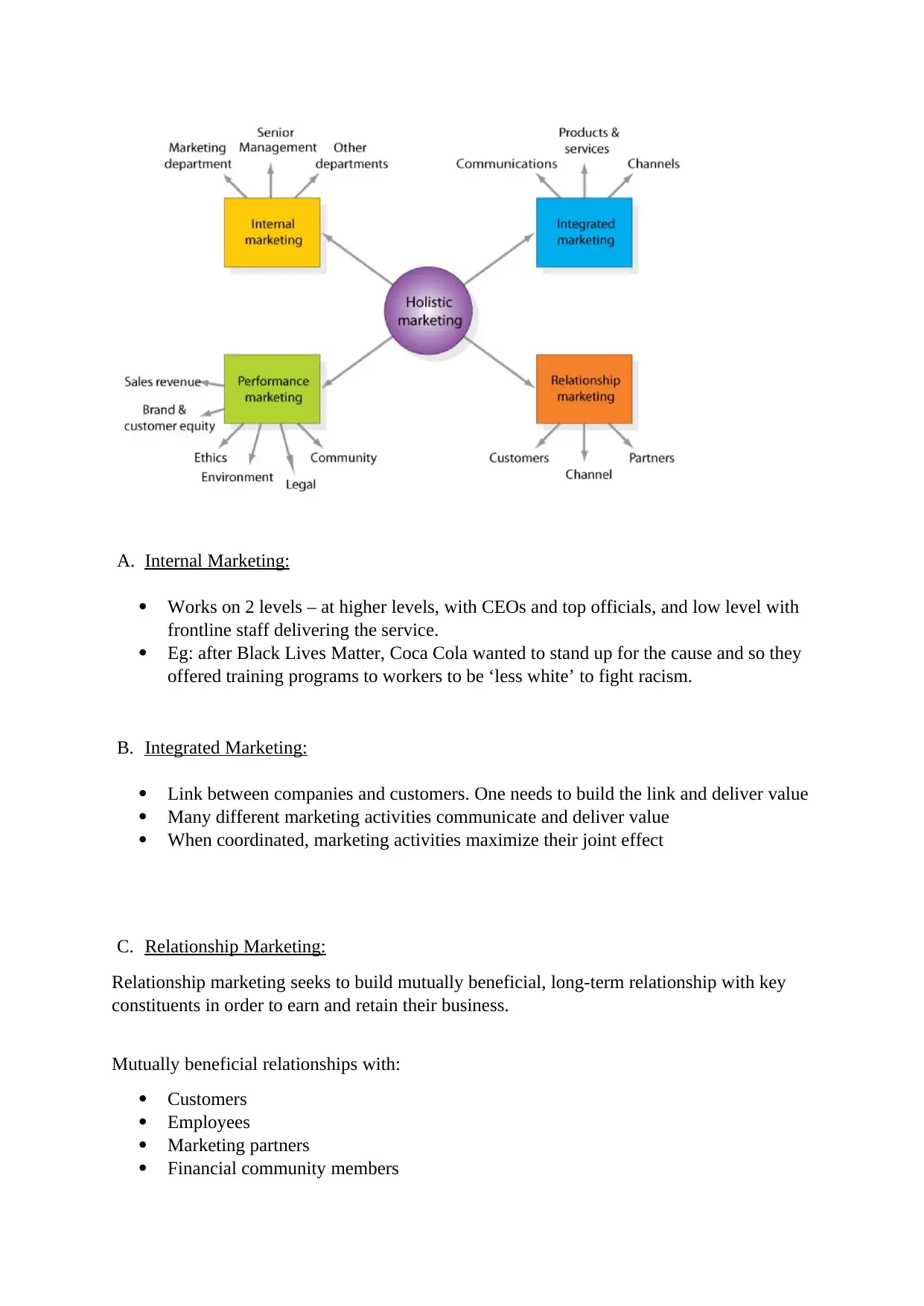
A. Internal Marketing:
Works on 2 levels – at higher levels, with CEOs and top officials, and low level with
frontline staff delivering the service.
Eg: after Black Lives Matter, Coca Cola wanted to stand up for the cause and so they
offered training programs to workers to be ‘less white’ to fight racism.
B. Integrated Marketing:
Link between companies and customers. One needs to build the link and deliver value
Many different marketing activities communicate and deliver value
When coordinated, marketing activities maximize their joint effect
C. Relationship Marketing:
Relationship marketing seeks to build mutually beneficial, long-term relationship with key
constituents in order to earn and retain their business.
Mutually beneficial relationships with:
Customers
Employees
Marketing partners
Financial community members
Works on 2 levels – at higher levels, with CEOs and top officials, and low level with
frontline staff delivering the service.
Eg: after Black Lives Matter, Coca Cola wanted to stand up for the cause and so they
offered training programs to workers to be ‘less white’ to fight racism.
B. Integrated Marketing:
Link between companies and customers. One needs to build the link and deliver value
Many different marketing activities communicate and deliver value
When coordinated, marketing activities maximize their joint effect
C. Relationship Marketing:
Relationship marketing seeks to build mutually beneficial, long-term relationship with key
constituents in order to earn and retain their business.
Mutually beneficial relationships with:
Customers
Employees
Marketing partners
Financial community members
⊘ This is a preview!⊘
Do you want full access?
Subscribe today to unlock all pages.

Trusted by 1+ million students worldwide
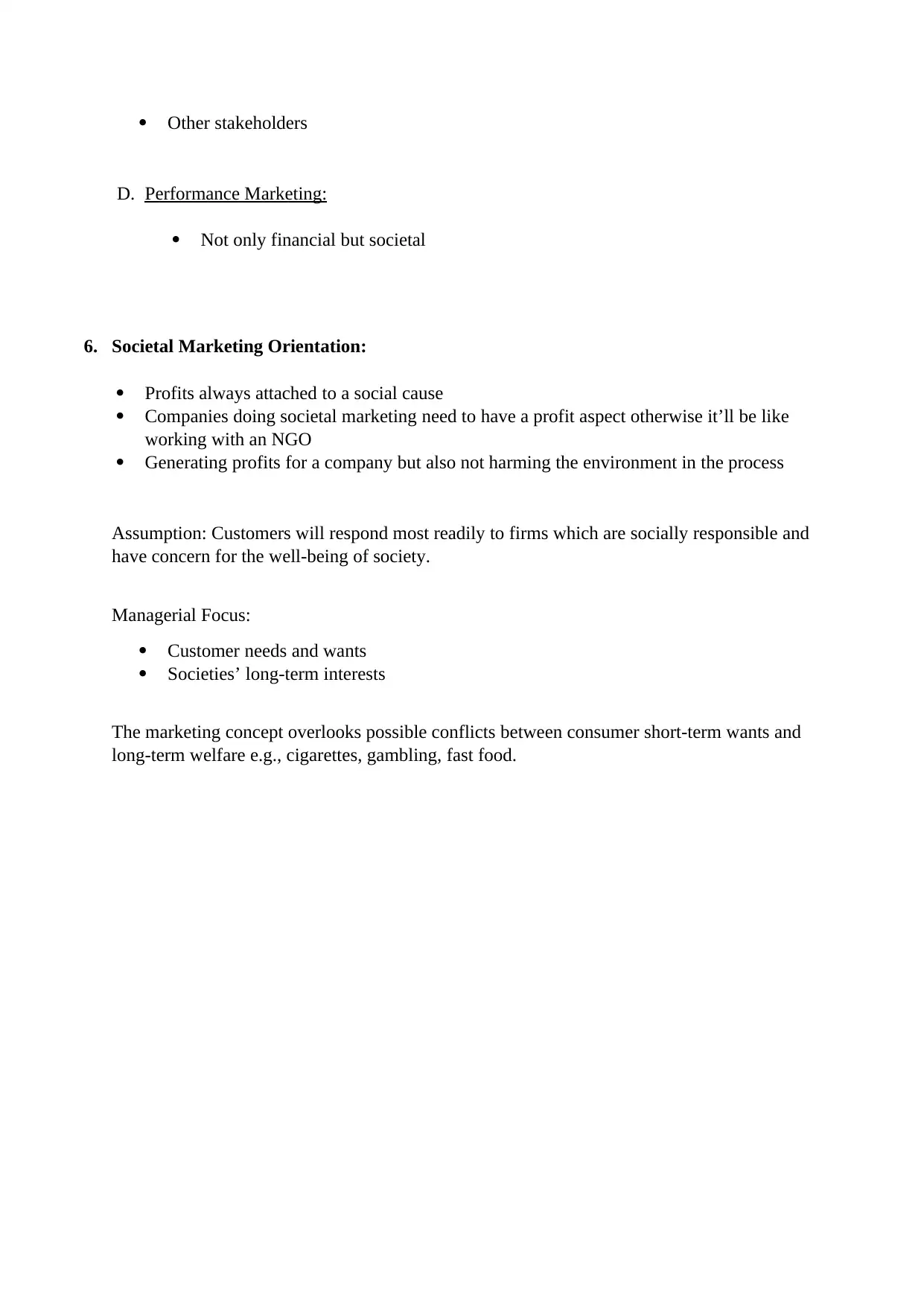
Other stakeholders
D. Performance Marketing:
Not only financial but societal
6. Societal Marketing Orientation:
Profits always attached to a social cause
Companies doing societal marketing need to have a profit aspect otherwise it’ll be like
working with an NGO
Generating profits for a company but also not harming the environment in the process
Assumption: Customers will respond most readily to firms which are socially responsible and
have concern for the well-being of society.
Managerial Focus:
Customer needs and wants
Societies’ long-term interests
The marketing concept overlooks possible conflicts between consumer short-term wants and
long-term welfare e.g., cigarettes, gambling, fast food.
D. Performance Marketing:
Not only financial but societal
6. Societal Marketing Orientation:
Profits always attached to a social cause
Companies doing societal marketing need to have a profit aspect otherwise it’ll be like
working with an NGO
Generating profits for a company but also not harming the environment in the process
Assumption: Customers will respond most readily to firms which are socially responsible and
have concern for the well-being of society.
Managerial Focus:
Customer needs and wants
Societies’ long-term interests
The marketing concept overlooks possible conflicts between consumer short-term wants and
long-term welfare e.g., cigarettes, gambling, fast food.
Paraphrase This Document
Need a fresh take? Get an instant paraphrase of this document with our AI Paraphraser
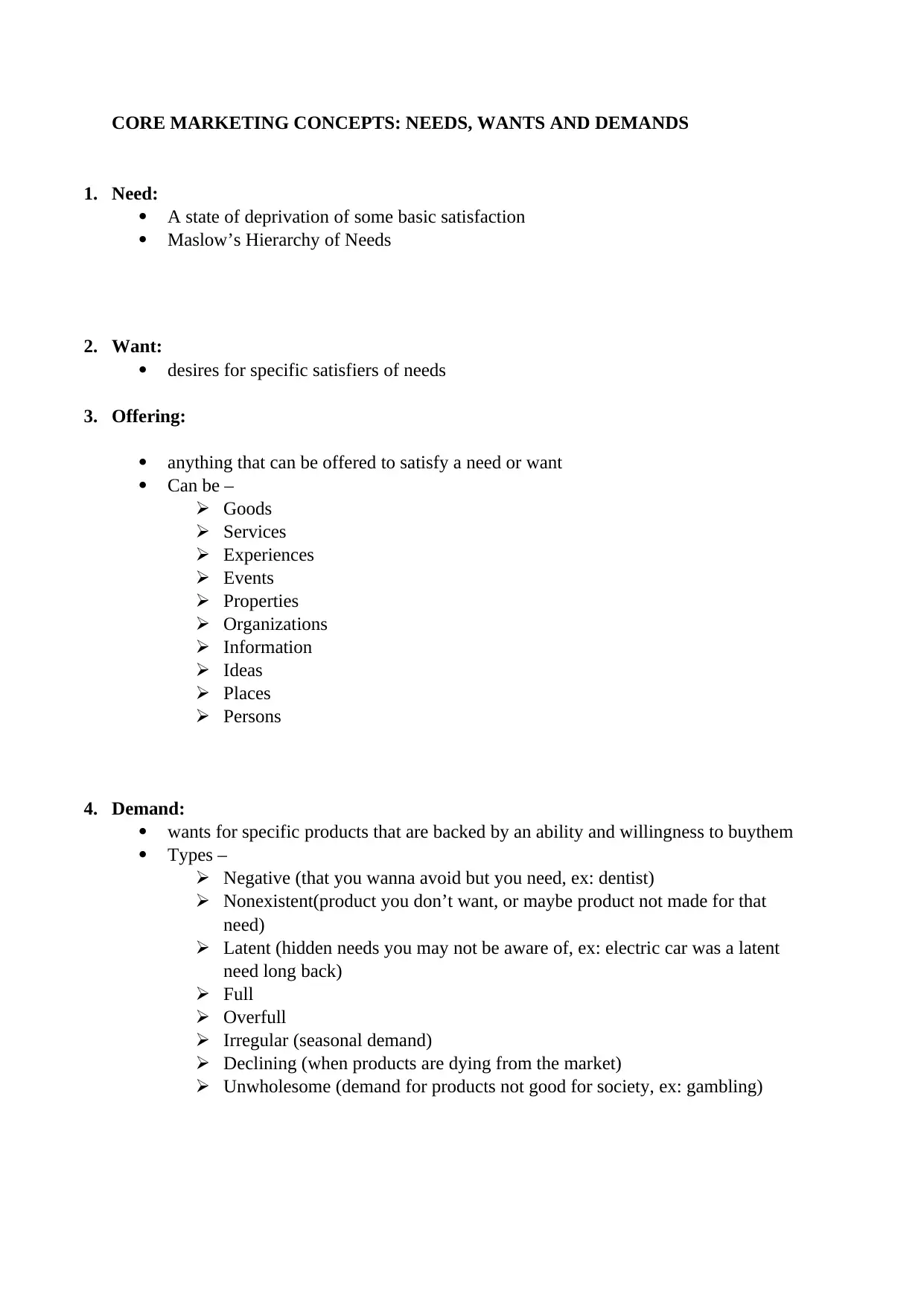
CORE MARKETING CONCEPTS: NEEDS, WANTS AND DEMANDS
1. Need:
A state of deprivation of some basic satisfaction
Maslow’s Hierarchy of Needs
2. Want:
desires for specific satisfiers of needs
3. Offering:
anything that can be offered to satisfy a need or want
Can be –
Goods
Services
Experiences
Events
Properties
Organizations
Information
Ideas
Places
Persons
4. Demand:
wants for specific products that are backed by an ability and willingness to buythem
Types –
Negative (that you wanna avoid but you need, ex: dentist)
Nonexistent(product you don’t want, or maybe product not made for that
need)
Latent (hidden needs you may not be aware of, ex: electric car was a latent
need long back)
Full
Overfull
Irregular (seasonal demand)
Declining (when products are dying from the market)
Unwholesome (demand for products not good for society, ex: gambling)
1. Need:
A state of deprivation of some basic satisfaction
Maslow’s Hierarchy of Needs
2. Want:
desires for specific satisfiers of needs
3. Offering:
anything that can be offered to satisfy a need or want
Can be –
Goods
Services
Experiences
Events
Properties
Organizations
Information
Ideas
Places
Persons
4. Demand:
wants for specific products that are backed by an ability and willingness to buythem
Types –
Negative (that you wanna avoid but you need, ex: dentist)
Nonexistent(product you don’t want, or maybe product not made for that
need)
Latent (hidden needs you may not be aware of, ex: electric car was a latent
need long back)
Full
Overfull
Irregular (seasonal demand)
Declining (when products are dying from the market)
Unwholesome (demand for products not good for society, ex: gambling)
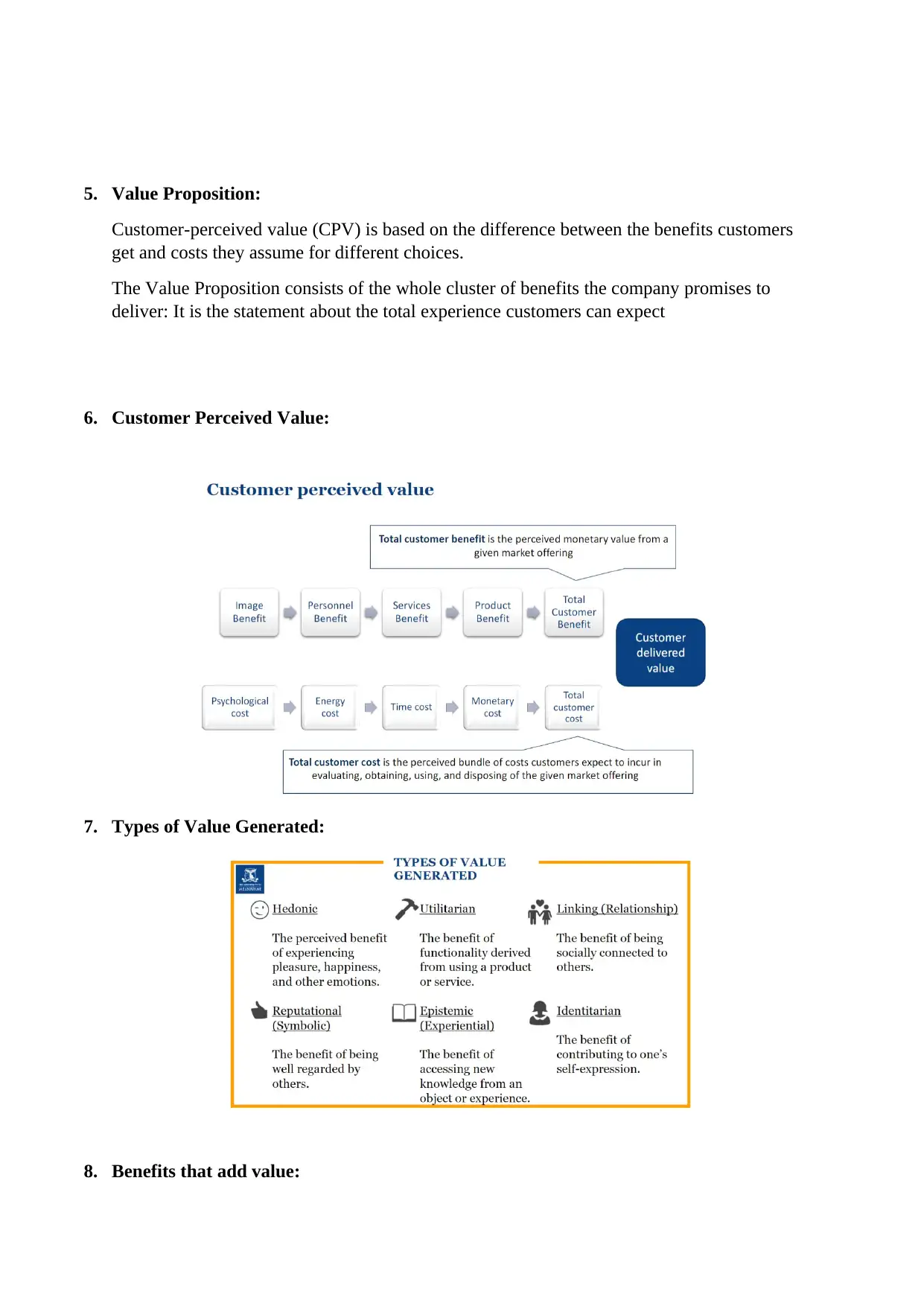
5. Value Proposition:
Customer-perceived value (CPV) is based on the difference between the benefits customers
get and costs they assume for different choices.
The Value Proposition consists of the whole cluster of benefits the company promises to
deliver: It is the statement about the total experience customers can expect
6. Customer Perceived Value:
7. Types of Value Generated:
8. Benefits that add value:
Customer-perceived value (CPV) is based on the difference between the benefits customers
get and costs they assume for different choices.
The Value Proposition consists of the whole cluster of benefits the company promises to
deliver: It is the statement about the total experience customers can expect
6. Customer Perceived Value:
7. Types of Value Generated:
8. Benefits that add value:
⊘ This is a preview!⊘
Do you want full access?
Subscribe today to unlock all pages.

Trusted by 1+ million students worldwide
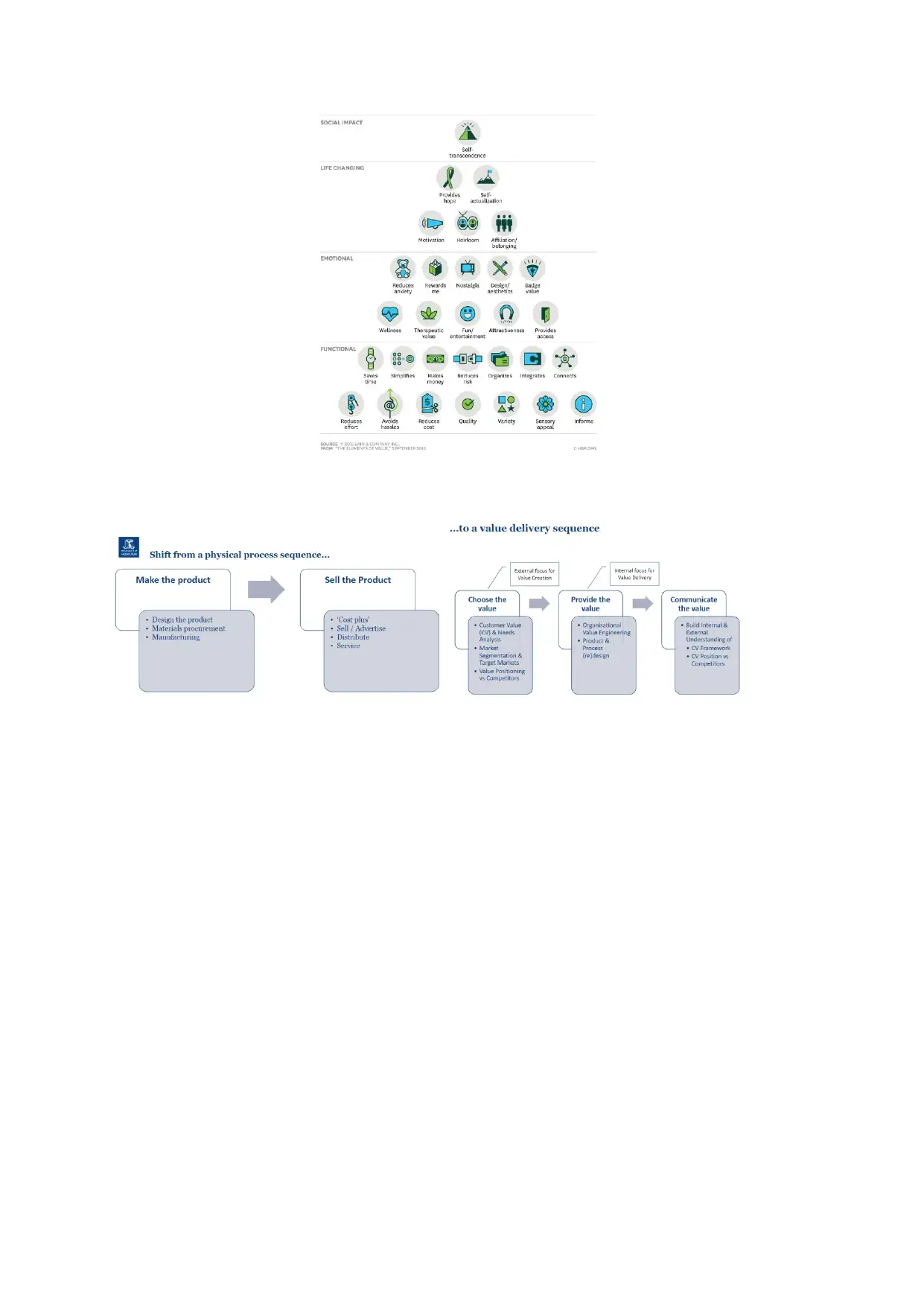
1 out of 10
Your All-in-One AI-Powered Toolkit for Academic Success.
+13062052269
info@desklib.com
Available 24*7 on WhatsApp / Email
![[object Object]](/_next/static/media/star-bottom.7253800d.svg)
Unlock your academic potential
Copyright © 2020–2025 A2Z Services. All Rights Reserved. Developed and managed by ZUCOL.